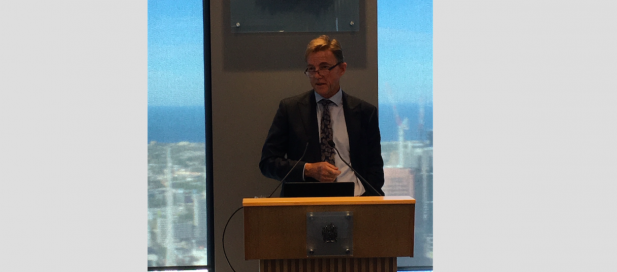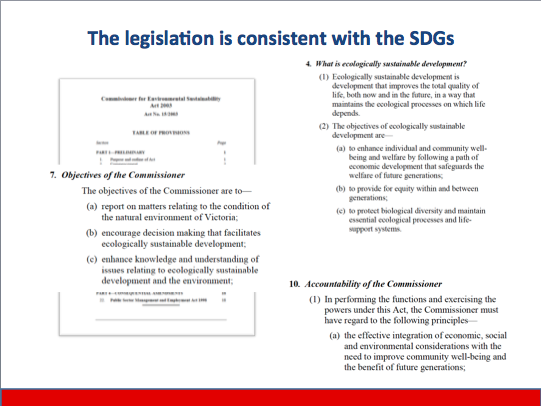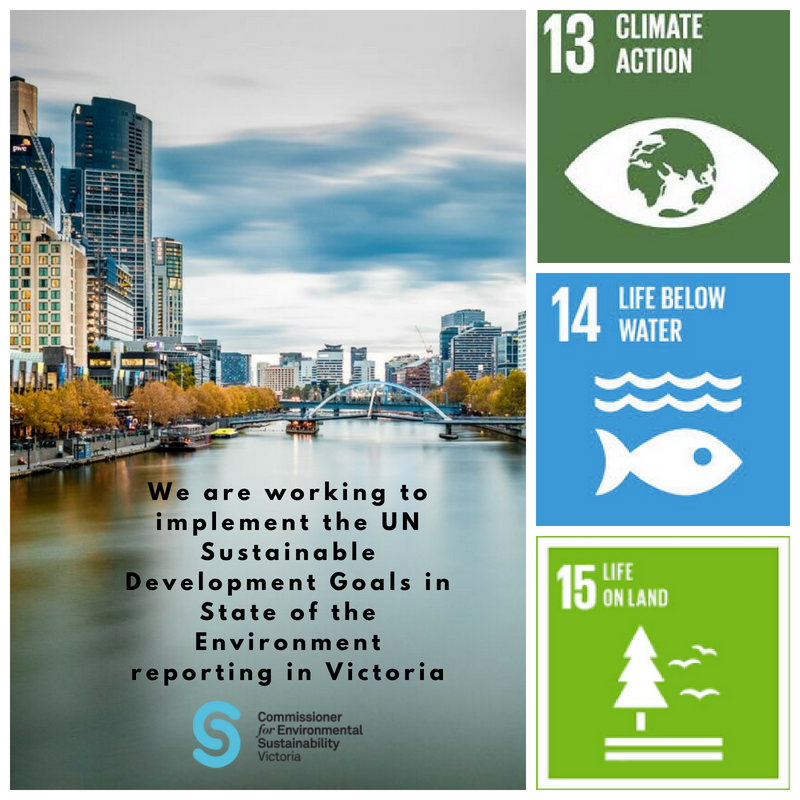
As we come to the end of the financial year, I wanted to share an update of the work of my team in the Office of the Commissioner for Environmental Sustainability. Next week we enter year five of the five-yearly, State of the Environment (SoE) reporting cycle for Victoria. The 2018 report will be completed by the end of this calendar year and tabled in early 2019. Given the interest in our work and the forthcoming Victorian State election, my Office has, for the first time, prepared an Interim SoE report which we will release during July.
The Interim SoE report is being developed as a part of the process of preparing the full SoE report and is intended as a ‘progress report’ that will:
- Assist production of a high quality SoE report
- Resemble the same structure as the final report
- Reference indicators to be reported on in the 2018 SoE, State of the Yarra & its Parklands and State of the Forests reports
- Discuss issues and challenges for monitoring and reporting in Victoria but will not include a synthesis of findings or recommendations.
With three reports underway this year and the Interim SoE report on track for a mid-year release, our Office has had a busy, productive and fruitful period in terms of science reporting, advocacy and practical action this SoE reporting cycle. Guided by the principles set out in the State and Benefit framework, we write our reports and also use our platform to advocate for contemporary approaches that will create better reports such as:
- Getting better information - not just the information we can get but shifting to getting the information that we need for better understanding
- Introducing SDGs and socio-economic indicators to SoE
- Demonstrating the application of environmental economic accounting as a tool to quantify environmental benefit
- Using digital platforms to enable citizens to better participate in the understanding of that information.
So throughout this cycle the style of the reports we produce is evolving in order to create more useful, relevant information for business, government and the wider community because we cannot afford to be complacent in our need to understand and protect the environment. That is why our Office has been working hard to apply new tools and strategies to bring the Commissioner for Environmental Sustainability Act 2003 to life in new ways and ensure that we walk the talk and implement our mandate to encourage decision making that facilitates ecologically sustainable development in Victoria.

In this endeavour, the UN’s Sustainable Development Goals (SDGs) are game-changing for the work of the Office.
When the Victorian Government passed the CES Act in 2003 it was visionary at the time and included as an objective of the Commissioner, to encourage decision-making that facilitates ecologically sustainable development (ESD), (and I want to acknowledge John Thwaites for his vision and leadership as the responsible Minister at the time).
“In my role as Commissioner, the Act states that it is my job to take into account ‘the effective integration of economic, social and environmental considerations with the need to improve community, wellbeing and the benefit of future generations.’ The SDGs help bring this accountability to life."
Fast forward to 2018 and we now have the framework to better fulfil this objective – the UN SDGs give us the framework to underpin reporting that encourages decision making for ESD. The SDGs – 230 indicators and 169 targets are vital for future planning. I will discuss the use of these targets and indicators in greater detail in the “Future Focus 2030” section of the State of the Environment Report 2018 and explain how Victoria can use the SDGs as a framework for reporting by the Commissioner, in future SoE reports.

For example, my team has been collaborating with the Monash Sustainable Development Institute MSDI to develop socio-economic indicators for the 2018 SoE report based on the SDGs. The project, underway since 2017, has focused on narrowing the list of SDG indicators to those that are relevant to SoE reporting. Our Office had a breakthrough with this project in February this year with the successful implementation of a high-level workshop ‘Applying the SDGs – Determining Socio-Economic Indicators for Victoria's Environment’. An interactive workshop in February 2018 introduced key leaders across government, business, community and NGOs to potential socio-economic indicators for SoE reporting. Real-time online polling (using Slido which worked seamlessly) was used by all delegates to rank 29 SDG targets according to their priority.
The aim of the workshop was to determine the socio-economic indicators for SoE reporting in Victoria. The methodology being developed is a first for Australia. I presented a sneak peak of the findings at the National SDG Summit in Melbourne in March and will present the findings at the International Conference for Sustainable Development in New York ICSD 2018 at Columbia University in September 2018.

As mentioned earlier, guided by the principles set out in the State and Benefit framework we use our platform as science writers to advocate for contemporary approaches that will create better reports and have been expanding our reporting model from preparing ‘science reports for scientists’ to a matrix type model that speaks to broader, crosscutting issues that impact what our Office can do and the impact our work can have. That is why we talk about opportunities such as:
- Frameworks for ecologically sustainable development
- Traditional Owner engagement and contribution
- Alignment with international frameworks
- The digital economy/digital reporting/real-time monitoring
- Sustainable Development Goals (SDGs)
- System of Environmental Economic Accounts (SEEA)
- The influence of citizen science
I want to thank my small but effective team (boy do they punch above their weight!) who work tirelessly to ensure we are connecting, communicating and sharing our work. We are committed to ensuring that we can maximise the impact of our reporting and expertise through our website, social media feeds and networking events across the business, community and government sectors. Recent highlights include @NCCARF conference Climate Adaptation 2018, the #OCOC Catchments Summit and the Shared Value Summit APAC Shared Value Australia. Scott Rawlings, Rebecca Koss and myself have been privileged to speak at a range of events including The Victorian Public Sector Young Leaders Conference; Rebecca hosted a fantastic workshop as part of her work with the Joan Kirner Young and Emerging Women Leaders program where she invited Bridie O’Donnell, Ecca Vandal and myself to share our leadership journeys.
The opportunity to immerse myself in all things shared value for two days in Sydney in April was important because companies committed to a shared value (SV) ethos are an important audience for our reports. These folk are developing and delivering business opportunities that also support communities and protect the environment.
YouTube - Mark Kramer: The Importance of Creating Shared Value
Along with the UN Sustainable Development Goals, these are game changing new ways of thinking and doing business – all important considerations for us in our report writing and in our role as advocates for the environment.
This year has also seen good progress on the integration of environmental-economic accounting on decision-making at the highest levels of government. At the Meeting of Environment Ministers (MEM), involving the Commonwealth Minister for the Environment and Energy and the Environment Minister from each Australian state and territory, I am very pleased to see that the introduction of the UN proposed System of Environmental-Economic Accounting (SEEA) has been endorsed by MEM, supporting a “common national approach to environmental-economic accounting and the free and open sharing of environmental data between jurisdictions.”
I have been an advocate for investment in environmental economic accounting skills and capabilities by governments since my appointment in 2014 and this decision by MEM is encouraging.
The final pillar in the reforms of the Office centre on digital reforms which, if you follow this feed, you will know I have a strong interest in the use of disruptive technologies as a gamechanger for data democracy and environmental justice. A key example of progress in this area has been Andrea Hinwood’s leadership on the improvement of air quality monitoring at the EPA including leading the response to improve EPA’s science and digital monitoring capabilities (e.g. through action 6.3 of the EPA Inquiry.)
My reflection as we enter year five of five of this SoE reporting cycle is that there has been a great deal of good progress made to improve environmental policy and practice in Victoria during my term as Commissioner. It is particularly pleasing to see the reforms and investments that we are advocating for being realised.
All systems go
It is all systems go with the release of the State of the Environment Interim report in late July 2018, with preparations underway for government briefings over the coming weeks. Lead Science Writer Rebecca Koss is well advanced in her work on the State of the Yarra and its Parklands report; Head of Science and Research Scott Rawlings is concentrating on the State of the Environment. We are also preparing State of the Forests. Separately we are scoping a performance report on the outcomes of environmental water (action 3.6 Water for Victoria, Water Plan) and have new reporting tasks from the Biodiversity 2037 plan and a State of the Marine and Coastal Environment report on the horizon.
So we have loads of work underway and much more to be done so that we can shine a light on the areas for “Future Focus to 2030” in the 2018 SoE report and keep working together to maintain a healthy environment.
Finally, if you are in any doubt about the way environmental reporting is changing, have a look at how the mainstream media is using data and information differently with weather presenters bringing climate change into the home.
Exciting times. Expect better information, better decisions, better outcomes.
It’s delivery time.
